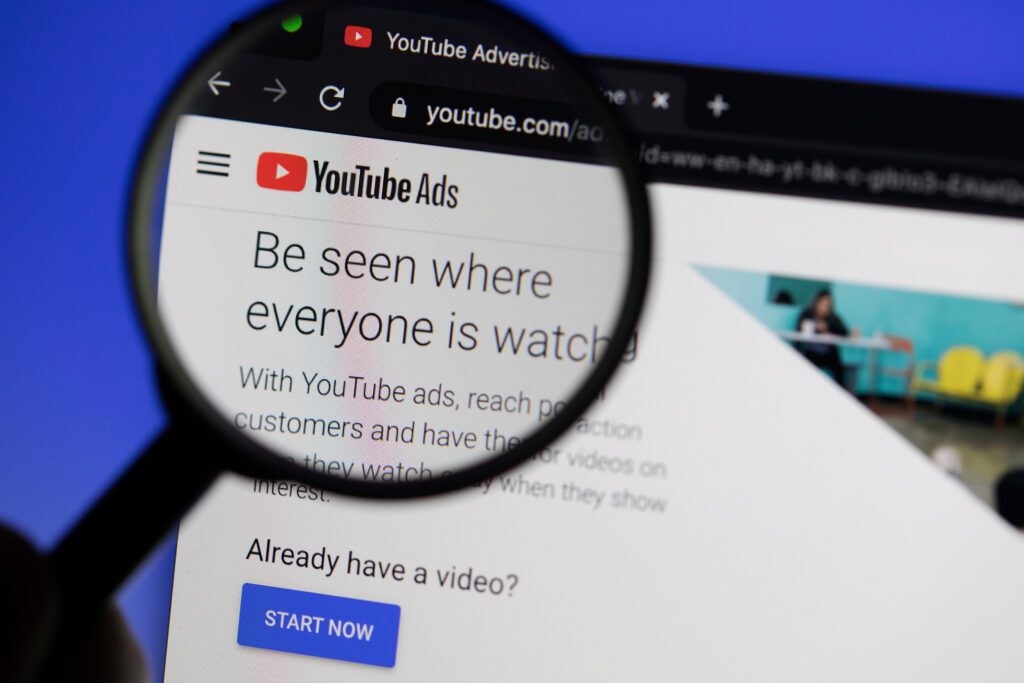
Why You May Not Be Seeing Good ROI with YouTube Ads

YouTube Ads can be a powerful tool for driving sales, but many businesses don’t always see the returns they desire. There could be a variety of reasons why your YouTube Ads campaigns may not be delivering good Return on Investment (ROI). In this article, we’ll discuss some of the most common causes. We’ll look at everything from miscalculated budgets to poorly targeted audiences to determine what factors might be preventing you from getting the results you want from your YouTube Ads campaigns.
Table of Contents:
- What’s “Good” ROI?
- Consequences of “Bad” ROI
- 10 Reasons you May Not be Seeing Good ROI with YouTube Ads
- Improve your ROI on YouTube Ads
- Final Thoughts
- We’re Here to Help
What’s “Good” ROI?
Let’s first talk about what ROI is and, more plainly, what “good” ROI is. Good ROI is when you can make more money than you spend on a marketing campaign. A good way to measure ROI with YouTube Ads is by comparing the cost of running the ads against the amount of revenue generated from those ads. If there’s a significant difference between what you spent and what you earned, then your YouTube Ads campaigns are delivering good ROI.

Consequences of “Bad” ROI
Poor return on investment (ROI) can seriously impact your business. A negative ROI indicates that you are not generating enough revenue to cover the costs of running your business, which means you will eventually run out of money and go into debt. Furthermore, it can lead to decreased customer satisfaction as people become less likely to invest in your products or services. If the ROI continues to remain low, it could eventually lead to bankruptcy.
Therefore, it is important to be aware of how ROI affects a business and understand how to measure and improve the return on investment for your company. Understanding what makes up a successful ROI can help you make informed decisions that will improve your overall business performance and increase profits. Additionally, it is important to take appropriate steps to monitor ROI and adjust services or products accordingly in order to ensure that the return remains positive. By doing this, you can make sure that your business continues to thrive and generate a healthy profit margin.
If you’re not seeing good ROI with your YouTube Ads campaigns, it could indicate a few different issues. It could either be that the ads are poorly targeted, not reaching the right audience or that the budget is miscalculated and too low for effective results. Without understanding what’s causing the bad ROI, making meaningful changes and improvements to your campaigns can be difficult.
10 Reasons you May Not be Seeing Good ROI with YouTube Ads
1. Poorly Defined Goals
Failing to define a clear goal for your YouTube Ads campaigns can make it challenging to measure success. Developing specific goals, such as increasing traffic and leads or reaching a certain number of views, is key to ensuring ROI.
When defining goals for your YouTube Ads campaigns, consider the following:
- What are the objectives of your campaign?
- What is the desired outcome or result?
- Who is your target audience and what do you want them to do as a result of watching your ads?
- How will you measure success and determine ROI?
Answering these questions will help you to create a clearer picture of your goals and set measurable objectives for your campaigns. With well-defined goals in place, you can then analyze the performance of your ads and adjust them accordingly to ensure that the desired outcomes are achieved.
By carefully planning out and defining clear goals ahead of time, you can ensure that your YouTube Ads campaigns are successful and deliver the results you’re hoping for.
2. Low Audience Engagement
If your ads aren’t engaging with the right audience, you won’t see the desired results. Revisit your targeting frequently to make sure you’re reaching an audience that’s likely to click through and purchase from your site.
To identify your target audience, we recommend you:
- Research your competitors to see who they’re targeting
- Analyze the performance of past ads and adjust your targeting accordingly
- Leverage YouTube’s advanced audience targeting features such as demographics, interests, and behaviors.
Interested in learning more about your audience and finding the right target audience? Here are a few of our blogs all about researching your audience:
- Do You Really Know Your Audience, Or Are You Just Guessing?
- How Competitor Research And Analysis Can Help Your Business
- Marketing Hack – Three Ways To Research Your Ideal Audience And What You Should Be Looking For
3. Wrong Video Format
Different video formats work better for different campaigns, so choose the right format for your ad before launching it on YouTube. Using the wrong video format for your campaign can have a dramatic effect on ROI. For example, if you’re trying to sell a product and use an explainer video instead of an ad, viewers might not take action after watching it because it wasn’t designed to do so.
4. Poor Quality Video
Poor-quality videos are less likely to engage viewers and can damage your brand’s reputation. So instead, invest in high-quality video content that conveys a clear and professional message.
5. Unclear Call To Action
A compelling call to action is essential for getting users to take the desired action. So make sure your CTA is clear, concise, and relevant to the audience you’re targeting.

6. Miscalculated Budget
When it comes to YouTube Ads, budgeting correctly is key to seeing ROI. Make sure you calculate your budget accurately based on how much you can afford to spend in total and how much should be allocated per ad campaign or video view. Figuring out your budget for YouTube Ads is an important step in ensuring ROI. Start by calculating how much you can afford to spend in total on your ad campaigns and then decide how much should be allocated per video view or ad campaign. Don’t forget to factor in the amount of time it will take you to launch a campaign and track its progress so that you can adjust accordingly if needed.
7. No Testing & Tracking
Without testing and tracking, it’s difficult to determine which ads are performing well and which need to be tweaked. Test multiple ad variations before running a full campaign and use analytics tools to measure the performance of your campaigns. Tracking your YouTube Ads can help you identify areas for improvement and optimize your campaigns. With the right tracking, you can gain insight into what ads are performing well, where they’re having the most impact, and who is viewing them. This data can then be used to refine your existing campaigns and develop new ones. Additionally, tracking allows you to see which channels have the highest ROI so that you can focus more of your budget on those channels in order to maximize returns.
8. Poor Keyword Optimization
Keyword optimization is the process of researching and selecting keywords that are related to your product or service and will be used for marketing purposes. It involves finding relevant words which users might search for when looking for something similar to what you offer, then incorporating those words into titles, descriptions, tags, and other content areas in order to increase visibility on search engines.
Incorrectly using keywords in titles, descriptions, or tags can make your videos hard to find for those searching for them. Instead, make sure you optimize the keywords used in your YouTube Ads for maximum visibility.
9. Ignoring Video Metrics
Regularly monitoring metrics such as views, likes, shares, and comments will help you track progress and identify areas that need improvement or further boosting with paid advertisements. You can track video metrics such as views, likes, shares, and comments using YouTube Analytics. The analytics dashboard will show you data on impressions, engagement rates, watch time and more. You can also use third-party tools to get additional insights into your video performance.
10. Not Re-Marketing
Re-marketing is a type of online advertising that allows you to target people who have already visited your website with ads. This technique helps you reach users who are more likely to convert because they’ve shown interest in your products or services before. When someone visits your site, a cookie will be placed on their computer, and you can then use that cookie to show them ads as they browse the web. This type of online advertising is highly effective because it’s targeted at people who already know something about your brand, increasing the chance that they will convert.
YouTube offers several re-marketing options. You can target viewers based on their interactions with other YouTube videos, including how many times they’ve watched, how long they watched for, which channels they watch and more. You can also target viewers based on their interests or even previous searches. These options allow you to create highly targeted campaigns that drive conversions.
Overall, re-marketing is an invaluable tool to help boost your ROI and reach your target audience with relevant ads. With YouTube’s re-marketing options, you can create campaigns that are tailored to your exact specifications and get the most out of your budget. Take advantage of this feature to maximize your ROI and increase conversions.
Improve your ROI on YouTube Ads
To get better ROI on YouTube Ads, start by ensuring that you’re targeting the right people with your ads. Use YouTube’s powerful targeting tools and take advantage of different demographic segments to ensure that your ads reach the most relevant audiences. Additionally, consider increasing your budget if it’s too low, as this can help you reach a wider audience. Finally, make sure to A/B test different versions of your ad and optimize for conversions to ensure that you’re getting the most bang for your buck. By following these steps, you can get better ROI from your YouTube Ads campaigns.
Improving your YouTube ROI can bring many benefits to your business, such as increasing website traffic and conversions. Additionally, optimizing YouTube Ads can help you reach new audiences that may not have known about your business before. Gaining more visibility will also help build brand recognition and trust among potential customers. Finally, improving your ROI on YouTube Ads helps you get the most out of your budget by ensuring that each dollar is being used efficiently. All these benefits make it worth investing time and effort into getting better ROI from YouTube Ads.

Final Thoughts
When it comes to getting good ROI from YouTube Ads, there’s no one-size-fits-all solution. Every business is different, and many factors can affect an ad campaign’s success. By taking a closer look at why your campaigns might not be delivering the desired results, you can make adjustments and hopefully get better returns in the future. From budget considerations to creative assets to conversion rate optimization, there are numerous things that you can do to improve your ROI with YouTube Ads. With a little trial and error, you can find the right formula for success.
We’re Here to Help!
Overall, there are a variety of reasons why you might not be seeing good ROI with YouTube Ads, and understanding how each of these factors contributes to the success of your campaign is essential for achieving better results. By targeting the right audience, creating attractive ad creatives, and setting a budget that gives your ads enough time to run, you can ensure that your YouTube Ads campaigns are successful in driving sales.
If you’re ready to optimize your YouTube ads for a better ROI and want professional guidance reach out to Two Trees PPC. Our team has years of experience driving successful results for businesses across various industries, and we have the expertise to develop comprehensive strategies that are tailored to meet your specific goals. Contact us today for a free consultation! By leveraging our knowledge, resources, and insights, you’ll be able to optimize your ads and see higher returns from your YouTube Ad campaigns. Get in touch with us now to discuss how we can help you drive more sales with YouTube Ads.


